Ever noticed that sickness rates shoot up during a digital transformation?
We all know this is because of the immense challenges, stresses, and emotional strain caused by all the changes at your organization during a transformation.
The problem is these changes have to happen to remain competitive against peers who are constantly researching and investing in new technologies.
Wouldn’t it be great if your organization could move with these changes, even have changed as part of its core philosophy?
You’re not dreaming: organizational agility exists for this precise reason! It allows everyone in your organization to embrace change by unlocking agility, incorporating it into every business process as you respond to rapidly changing market conditions.
The McKinsey State Of Organizations Report 2023 shows that only 50% of US companies surveyed stated that their organization was ready for external shocks and disruptions. This statistic shows how many companies do not effectively utilize organizational agility to respond to changing needs.
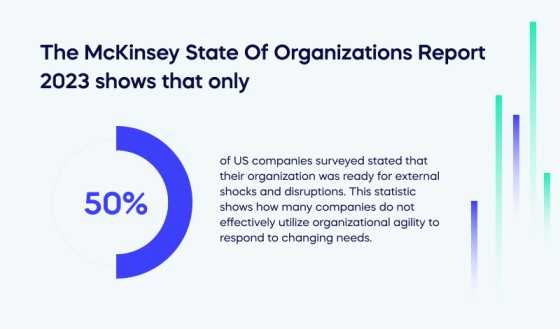
As a result, when they encounter more significant changes, such as a digital transformation, they know how to deal with it confidently, avoiding tears, departure, and sickness.
To help you understand the nature of and best practices of organizational agility to give you strategic flexibility for the future, we will explore the following topics:
- What is organizational agility in 2023?
- What are the five types of agility?
- What are the benefits of organizational agility?
- What are the challenges of organizational agility?
- Best practices for organizational agility
What is organizational agility in 2023?
Alina, please could we have a Venn diagram here like the one on this website: https://www.simpliaxis.com/resources/why-is-organizational-agility-important
I’d like the circles to be the same, with ‘Flexibility’ and ‘Fixedness’ on either side of them and Agile in the middle. But I’d like the title above the diagram: Organizational agility is about balance. And by the side of Flexibility: Too much change may be poorly considered, then by Fixedness: Not enough change and an organization lags behind competitors.
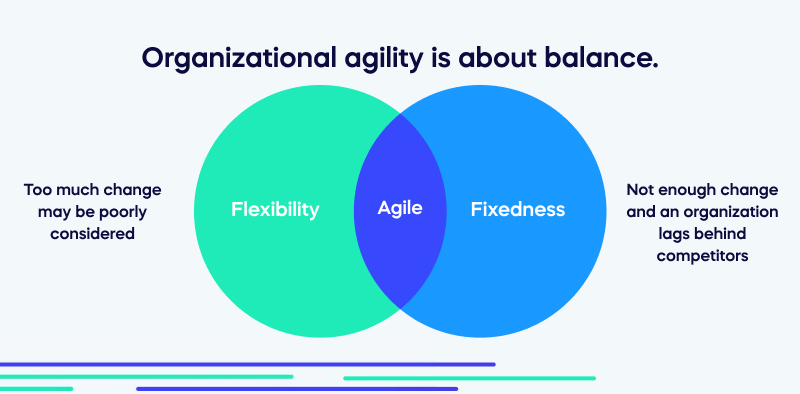
Organizational agility is a company’s capacity to quickly adjust or modify its strategies in response to market fluctuations, promoting digital resilience, boosting ROI, and maintaining employee retention. It all began with the agile software manifesto.
Building an agile organization involves making change a central pillar of an organization’s culture to ensure that it drives every decision for staff at all levels.
For example, in 2023, companies with high organizational agility adopted generative AI quickly, incorporating this technology into their tech stack before competitors to gain a competitive edge and build digital resilience with this agile approach.
However, it is essential to note that not all changes are helpful and that organizational agility is about remembering that agility requires stability.
Therefore, an organization’s dynamic capability to respond to change depends on a stable foundation to ensure leaders make the right decisions that stick.
Organizational agility vs. business agility: What’s the difference?
Although some people suggest organizational agility and business agility are different, they are often used in the same way, making sense in a business context. Both refer to an organization’s ability to respond to changes in the marketplace.
What are the five types of agility in the Learning Agility Scan?
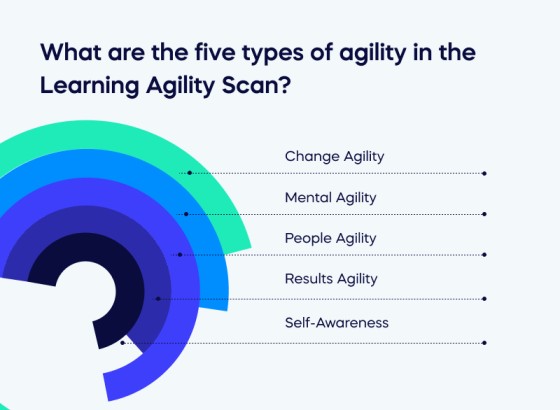
Your employees will identify with five types of agility in how they approach agility. It’s helpful to be aware of these agility types to tailor your approach to supporting your staff to engage in successful organizational agility efforts using the Learning Agility Scan.
1. Change Agility
Individuals who score high in Change Agility exhibit a constant curiosity piqued by encountering new and unfamiliar things.
Change agility employees move towards experimentation, enjoy exploring new experiences, and as a result, have more varied backgrounds as they appreciate and exhibit high levels of adaptability.
2. Mental Agility
Individuals with a high score in Mental Agility enjoy dealing with complex and ambiguous situations as they see them as a chance to generate fresh ideas and establish a new level of clarity.
They have an open-minded approach and enjoy interpreting unfamiliar concepts. As a result, they can identify patterns in new experiences faster than others.
3. People Agility
Individuals with a high People Agility score display positive behavior towards others and are receptive to those with diverse backgrounds and views.
They try to understand what other people mean and value their opinions. Doing so makes it easier for them to connect with others, and they gain knowledge from the input of others.
4. Results Agility
Individuals who score high in Results Agility tend to have a strong desire for success and constantly seek the most effective methods for achieving their goals. They are typically confident and driven and can maintain their composure when faced with pressure.
They can set goals more effectively in new and unfamiliar situations, allowing them to concentrate better and quickly differentiate between what is and isn’t relevant to succeed in resolving new issues.
5. Self-Awareness
Individuals who score high in Self-Awareness clearly understand their strengths and weaknesses. They tend to be self-critical and strive to improve their performance and behavior. As a result, they are more open to learning opportunities.
Using the Learning Agility Scan can help you quickly pinpoint employees who have the potential to sustain the strength and dynamism of your organization for the long term.
You can make the most engaged candidates Change Champions, who support other staff with questions and solutions to change problems throughout your organizational agility project.
What are the benefits of organizational agility?
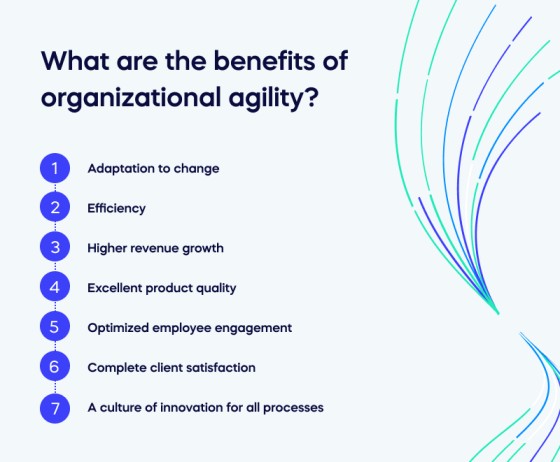
Knowing the benefits of organizational agility will help you optimize your investment in any agility project.
Adaptation to change
The business world is constantly evolving and often complicated, so something effective today may not be compelling tomorrow.
Organizations that can anticipate upcoming changes can accelerate their project management processes, allowing them to take advantage of new technologies, trends, and other opportunities. Consequently, these organizations are more likely to achieve success.
It is best to implement organizational agility in your business to adapt to change quickly. Doing so will help you prepare and make necessary shifts more efficiently.
Efficiency
Applying Agile methodology to a development team can transform the organization by prioritizing flexibility and significantly reducing wasted resources.
Higher revenue growth
Using the Agile methodology can lead to more significant long-term revenue for organizations.
If a company can act on new ideas and trends before its competitors, it can quickly release new products and services and attract new customers.
In addition, organizational agility relies on assigning precise tasks and roles to all personnel in a company.
Efficient performance by the executive team, based on a clear understanding of their tasks, can help reduce wasted hours and improve business revenue.
Excellent product quality
The agile methodology emphasizes continuous revisions, which provide opportunities to correct errors as they arise.
Optimized employee engagement
Employees are likely to be more engaged in a company that values and encourages exciting new projects and innovation, often characteristic of agile businesses. Therefore, organizational agility can lead to increased employee engagement.
Improve organizational agility to boost employee engagement, leading to a lower staff turnover rate.
Complete client satisfaction
Agility fosters a culture of open communication in the organization, where there will be ongoing feedback. This action will help the client feel included in the team, resulting in delivering the best possible product.
A culture of innovation for all processes
Organizational agility brings considerable benefit to innovation. Companies adopting organizational agility can use their disruptive ability to gain a competitive advantage, leading to long-term sustainability via actionable metrics for success.
What are the three main challenges of organizational agility?
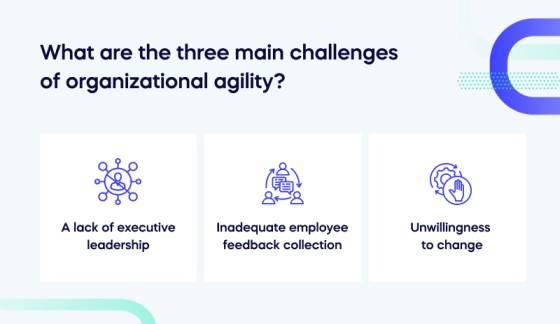
There are three main challenges to achieving organizational agility. It is essential to be aware of these challenges to begin planning how to resolve them when you invest in organizational agility.
1. A lack of executive leadership
If an organization doesn’t receive funding or support from the higher-ups, its transformation won’t last. Even if one department adopts organizational agility, but the others don’t, the concept will fail because the entire organization won’t support it.
2. Inadequate employee feedback collection
A formal and centralized program is required to implement organizational agility. Otherwise, if implemented isolatedly, it can create more problems than solve the existing ones.
3. Unwillingness to change
It is essential to understand that implementing Agile methodology will require a shift in the entire organization, including areas beyond product development.
One change that will be necessary is reducing the number of management layers so that you can give more attention to employee development, talent management, performance management, and collaborative use of business technology.
Best practices for organizational agility
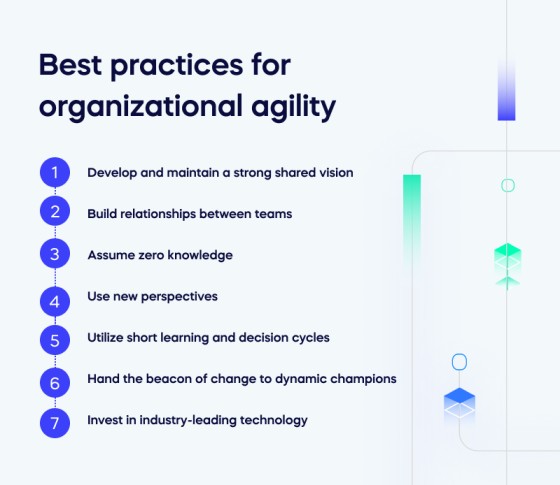
Follow these best practices to ensure success with your investment into organizational agility, helping your staff embrace change and ensure it sticks for maximum ROI.
Develop and maintain a strong shared vision
Agile organizations establish a collective purpose and vision for the company to create a sense of personal investment among employees. This action aids in aligning teams, even if they have different responsibilities and procedures.
Build relationships between teams
Agile organizations often replace the traditional hierarchical structure with flexible, scalable, cross-functional teams. These teams should prioritize alignment, accountability, expertise, transparency, and collaboration to use agile methods to create new initiatives quickly.
Team members must take ownership of their work and understand how it fits into the company’s shared vision, regardless of how the network operates.
Assume zero knowledge
It is no longer adequate to act like a know-it-all. The world is evolving rapidly, and innovative ideas can come from unexpected sources. Even unknown competitors can transform your industry.
Therefore, listening and approaching problem-solving with an open mind is crucial in this fast-paced environment, as this can lead to unique and game-changing solutions.
Use new perspectives
Instead of repeatedly asking questions with answers we already know, we should ask thought-provoking, open-ended questions that encourage creative discussions among employees and stakeholders.
Such questions may help us break free from our existing thought patterns.
Utilize short learning and decision cycles
Agile teams use short cycles, or sprints, to work and learn quickly. After each sprint, they collect user feedback, which they apply to improve the next sprint.
This model speeds up the organization’s work pace and emphasizes quarterly cycles and management systems like objectives and key results (OKRs) over annual planning.
Hand the beacon of change to dynamic champions
An agile culture focuses on people and aims to create value for diverse stakeholders such as employees, investors, partners, and communities. Making change personally relevant to employees can lead to a significant transformational impact.
Invest in industry-leading technology
Examining the technologies used to facilitate processes is necessary to revamp an organizational model completely. Doing so involves assessing tools such as real-time communication and work management, which can aid in developing dynamic operating procedures.
Use a DAP to embrace change and become an agile organization
Change is a natural part of the modern business landscape. Organizations must embrace it to keep up with today’s rapidly-evolving competitive environment.
Companies can facilitate change by implementing a detailed Digital Adoption Platform (DAP) to streamline their organizational agility.
A DAP allows businesses to lead their digital transformation – quickly, efficiently, and cost-effectively via in-app guidance and personalized learning so employees can train independently, using new digital tools as they work.
With support from the right technology, organizations can stay ahead of the competition while fostering meaningful changes that last well beyond any one CEO’s tenure to leverage the company’s ability to become an agile business.
Our globalized economy is on a course for extraordinary success – let’s take advantage of change and benefit from it by investing in organizational agility using a DAP today.
https://www.walkme.com/blog/wp-content/uploads/sites/2/2023/04/State-of-Digital-Adoption_67643bf1.png

